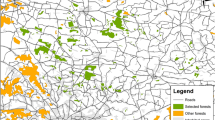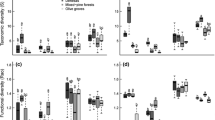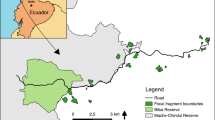Abstract
Often a single indicator invertebrate taxon is used for assessing changing landscape patterns. However, we argue here against the exclusive selection of a single group. Covariation in diversity patterns of spiders, carabids, staphylinids and ants were compared in and between five highly naturally-fragmented Afromontane forest patches (size range: 3.5–25.2 ha) in South Africa. Significantly fewer individuals and species were captured in smaller forest patches (<6 ha) for most of the taxa, except Formicidae, where a higher number of species were captured in medium-sized patches (7–9 ha). When sampling effort was standardized, a higher diversity (rarefaction and Simpson's diversity index) was obtained in the smaller patches for Carabidae, Staphylinidae and Formicidae. The only significant positive correlation between taxa, in terms of numbers of species, was between Carabidae and Staphylinidae. The other taxa showed only weak positive correlations between species richness, or negative correlations. Multivariate techniques showed significant species turnover between patch assemblages for each taxon, and also showed that some taxa are more similar in assemblage-structure than others. An index of complementarity showed that species compositions of the selected taxa varied greatly between forest patches of different sizes. Our results support the multi-taxa approach, in conservation studies, even at the level of taxonomically-related groups sharing a common habitat stratum.
Similar content being viewed by others
References
Adis, J. (1979) Problems in interpreting arthropod sampling with pitfall traps. Zool. Anz. 202, 177–84.
Angelstam, P. (1992) Conservation of communities – the importance of edges, surroundings and landscape mosaic structure. In Ecological Principals of Nature Conservation (L. Hansson, ed.), pp. 9–70. London: Elsevier Applied Science.
Baev, P.V. and Penev, L.D. (1995) BIODIV; program for calculating biological diversity parameters, similarity, niche overlap, and cluster analysis. Version 5.1. Moscow: Pensoft.
Báldi, A. and Kisbenedek, T. (1994) Comparative analysis of edge effect on bird and beetle communities. Acta Zool. Hung. 40, 1–14.
Beattie, A.J. and Oliver, I. (1994) Taxonomic minimalism. Trends Ecol. Evol. 9, 488–90.
Beattie, A.J. and Oliver, I. (1995) Taxonomic minimalism. Trends Ecol. Evol. 10, 203–4.
Brower, A.V.Z. (1995) Taxonomic minimalism. Trends Ecol. Evol. 10, 203.
Brown, Jr., K.S. (1991) Conservation of neotropical environments: insects as indicators. In The Conservation of Insects and their Habitats (N.M. Collins and J.A. Thomas, eds), pp. 350–404. London: Academic Press.
Burkey, T.V. (1993) Edge effects in seed and egg predation at two neotropical rainforest sites. Biol. Cons. 66, 139–43.
Campbell, I.C. (1995) Taxonomic minimalism. Trends Ecol. Evol. 10, 203.
Churchill, T.B. (1997) Spiders as ecological indicators: an overview of Australia. Mem. Mus. Victoria 56, 331–37.
Clarke, K.R. (1993) Non-parametric multivariate analysis of changes in community structure. Austr. J. Ecol. 18, 117–43.
Clarke, K.R. and Ainsworth, M. (1993) A method of linking multivariate community structure to environmental variables. Marine Ecol. Prog. Ser. 92, 205–19.
Clarke, K.R. and Green, R.H. (1988) Statistical design and analysis for a 'biological effects' study. Marine Ecol. Prog. Ser. 46, 213–26.
Clarke, K.R. and Warwick, R.M. (1994) Change in Marine Communities: An Approach to Statistical Analysis and Interpretation. 144pp. United Kingdom: Natural Environment Research Council.
Colwell, R.K. and Coddington, J.A. (1994) Estimating terrestrial biodiversity through extrapolation. Phil. Trans. Roy. Soc. Lond. B. 345, 101–18.
Desender, K, Maelfait, J-P. and Baert, L. (1991) Carabid beetles as ecological indicators in dune management (Coleoptera: Carabidae). Elytron suppl. 5, 239–47.
di Castri, F., Robertson Vernhes, J. and Younès, T. (1992) Inventorying and monitoring biodiversity. Biol. Internat. 27, 1–27.
Didham, R.K. (1997) The influence of edge effects and forest fragmentation on leaf litter invertebrates in central Amazonia. In Tropical Forest Remnants (W.F. Laurance and R.O. Bierregaard, eds), pp. 55–70. Chicago: University of Chicago Press.
Digweed, S.C., Currie, C.R., Carcamo, H.A. and Spence, J.R. (1995) Digging out the 'digging-in effect' of pitfall traps: influence of depletion and disturbance on catches of ground beetles (Coleoptera: Carabidae). Pedobiologia 39, 561–76.
Everard, D.A., Van Wyk, G.F. and Midgley, J.J. (1994) Disturbance and the diversity of forests in Natal, South Africa: lessons for their utilization. Strelitzia 1, 275–85.
Everard, D.A., Midgley, J.J. and Van Wyk, G.F. (1995) Dynamics of some forests in KwaZulu-Natal, South Africa, based on ordinations and size-class distributions. South Afr. J. Bot. 61, 283–92.
Forman, R.T.T. (1995) Land Mosaics: The Ecology of Landscapes and Regions. Cambridge: Cambridge University Press.
Friend, J.A. and Richardson, A.M.M. (1986) Biology of terrestrial amphipods. Ann. Rev. Entomol. 31, 25–48.
Geldenhuys, C.J. and MacDevette, D.R. (1989) Conservation status of coastal and montane evergreen forests. In Biotic Diversity in Southern Africa: Concepts and Conservation (B.J. Huntley, ed.), pp. 224–38. Cape Town: Oxford University Press.
Giller, P.S. (1996) The diversity of soil communities, the 'poor man's tropical rainforest'. Biod. Cons. 5, 135–68.
Greenslade, P.J.M. (1973) Sampling ants with pitfall traps: digging-in effects. Insectes Soc. 20, 343–53.
Hammond, P.M. (1990) Insect abundance and diversity in the Dumoga-Bone National Park, N. Sulawesi, with special reference to the beetle fauna of lowland rainforest in the Toraut region. In Insects and the Rain Forest of South East Asia (Wallacea) (W.J. Knight and J.D. Holloway, eds), pp. 197–254. London: Royal Entomological Society.
Hammond, P. (1994) Practical approaches to the establishment of the extent of biodiversity in speciose groups. Phil. Trans. Roy. Soc. Lond. B. 345, 119–36.
Hawkins, C.P. and MacMahon, J.A. (1989) Guilds: the multiple meanings of a concept. Ann. Rev. Entomol. 34, 423–51.
Hölldobler, B. and Wilson, E.O. (1990) The Ants. Cambridge, Mass: Harvard University Press.
Kempton, R.A. (1979) Structure of species abundance and measurement of diversity. Biometrics 35, 307–22.
Koen, J.H. and Crowe, T.M. (1987) Animal-habitat relationships in the Knysna Forest, South Africa: discrimination between forest types by birds and invertebrates. Oecologia 72, 414–22.
Kremen, C., Colwell, R.K., Erwin, T.L., Murphy, D.D., Noss, R.F. and Sanjayen, M.A. (1993) Terrestrial arthropod assemblages: their use in conservation planning. Cons. Biol. 7, 796–808.
Landres, P.B., Verner, J. and Thomas, J.W. (1988) Ecological uses of vertebrate indicator species: a critique. Cons. Biol. 2, 316–28.
Laurance, W.F. (1991) Edge effects in tropical forest fragments: application of a model for the design of nature reserves. Biol. Cons. 57, 205–19.
Lawton, J.H., Bignell, D.E., Bolton, B., Bloemers, G.F., Eggleton, P., Hammond, P.M., Hodda, M., Holt, R.D., Larsen, T.B., Mawdsley, N.A., Stork, N.E., Srivastava, D.S. and Watt, A.D. (1998) Biodiversity inventories, indicator taxa and effects of habitat modification in tropical forest. Nature 391, 72–76.
Lövei, G.L. and Sunderland, K.D. (1996) Ecology and behavior of ground beetles (Coleoptera: Carabidae). Ann. Rev. Entomol. 41, 231–56.
Luff, M.L. (1975) Some features influencing the efficiency of pitfall traps. Oecologia 19, 345–57.
Ludwig, J.A. and Reynolds, J.F. (1988) Statistical Ecology: A Primer on Methods and Computing. New York: Wiley.
MacArthur, R.H. and Wilson, E.O. (1967) The Theory of Island Biogeography. New Jersey: Princeton University Press.
Magurran, A.E. (1988) Ecological Diversity and its Measurement. Princeton: Princeton University Press.
Majer, J.D. (1978) An improved pitfall trap for sampling ants and other epigaeic invertebrates. J. Austr. Entomol. Soc. 17, 261–62.
May, R.M. (1981) Patterns in multi-species communities. In Theoretical Ecology: Principles and Applications (R.M. May, ed.), pp. 197–227. London: Blackwell.
May, R.M. (1989) How many species? In The Fragile Environment (L. Friday, L. and R. Laskey, eds), pp. 61–81. Cambridge: Cambridge University Press.
McGeoch, M.A. (1998) The selection, testing and application of terrestrial insects as bioindicators. Biol. Rev. 73, 181–201.
New, T.R. (1994) Conservation assessment of invertebrate assemblages: is there a place for global level taxon-focusing? Mem. Queensl. Mus. 36, 153–57.
New, T.R., Britton, D.R., Hinkley, S.D. and Miller, L.J. (1996) The Ant Fauna of Mount Piper and its Relevance to Environmental Assessment and the Conservation of a Threatened Invertebrate Community. Melbourne: Flora and Fauna Technical Report No. 143. Department of Natural Resources and Environment.
Niemelä, J. and Baur, B. (1998) Threatened species in a vanishing habitat: plants and invertebrates in calcareous grasslands in the Swiss Jura mountains. Biod. Cons., 7, 1407–16.
Oliver, I. and Beattie, A.J. (1993) A possible method for the rapid assessment of biodiversity. Cons. Biol. 7, 562–68.
Oliver, I. and Beattie, A.J. (1996) Designing a cost-effective invertebrate survey: a test of methods for rapid assessment of biodiversity. Ecol. Applic. 6, 594–607.
Oliver, I., Beattie, A.J. and York, A. (1998) Spatial fidelity of plant, vertebrate, and invertebrate assemblages in multiple-use forest in Eastern Australia. Cons. Biol. 12, 822–35.
Prendergast, J.R., Quinn, R.M., Lawton, J.H., Eversham, B.C. and Gibbons, D.W. (1993) Rare species, the coincidence of diversity hotspots and conservation strategies. Nature 365, 335–37.
Pressey, R.L., Johnson, I.R. and Wilson, P.D. (1994) Shades of irreplaceability: towards a measure of the contribution of sites to a reservation goal. Biod. Cons. 3, 242–62.
Preston, F.W. (1962) The canonical distribution of commonness and rarity: Part I, II. Ecology 43, 185–215, 410–32.
Putman, R.J. (1994) Community Ecology. London: Chapman & Hall.
Reid, W.V. (1998) Biodiversity hotspots. Trends Ecol. Evol. 13, 275–79.
Risser, P.G. (1995) The status of the science examining ecotones. BioScience 45, 318–25.
Samways, M.J. (1989) Taxon turnover in Odonata across a 3000 m altitudinal gradient in Southern Africa. Odonatologica 18, 263–74.
Samways, M.J. (1994) Insect Conservation Biology. London: Chapman & Hall.
Simberloff, D.S. (1978) Use of rarefaction and related methods in ecology. In Biological Data in Water Pollution Assessment: Quantitative and Statistical Analysis (K.L. Dickson, J. Garins, Jr. and R.J. Livingston, eds), pp. 150–65. American Society for Testing and Materials, STP 652.
Sokal, R.R. and Rohlf, F.J. (1995) Biometry 3rd$ ed. New York: Freeman.
Stork, N.E. (1994) Inventories in biodiversity: more than a question of numbers. In Systematics and Conservation Evaluation (P.L. Forey, C.J. Humphries and R.I. Vane-Wright, eds), pp. 81–100. Systematics Association Special Volume No. 50, Oxford University Press.
Stork, N.E. (1995) Measuring and inventorying arthropod diversity in temperate and tropical forests. In Measuring and Monitoring Biodiversity in Tropical and Temperate Forests (T.J.B. Boyle and B. Boontawee, eds), pp. 257–70. Indonesia: Center for International Forestry (CIFOR).
Stork, N.E. and Brendell, M.J.D. (1990) Variation in the insect fauna of Sulawesi trees with season, altitude and forest type. In Insects and the Rain Forests of South East Asia (Wallacea) (W.J. Knight and J.D. Holloway, eds), pp. 173–90. London: Royal Entomological Society.
Stork, N.E. and Eggleton, P. (1992) Invertebrates as determinants and indicators of soil quality. Am. J. Altern. Agric. 7, 38–47.
Sutton, S.L. and Collins, N.M. (1991) Insects and tropical forest conservation. In The Conservation of Insects and their Habitats (N.M. Collins and J.A. Thomas, eds), pp. 405–24. London: Academic Press.
Teketay, D. and Grandstrom, A. (1995) Soil seed banks in dry afromontane forests of Ethiopia. J. Veg. Sci. 6, 777–86.
Thiele, H.U. (1977) Carabid Beetles in their Environment. Berlin: Springer-Verlag.
Van der Merwe, M., Dippenaar-Schoeman, A.S. and Scholtz, C.H. (1996) Diversity of ground-living spiders at Ngome State Forest, KwaZulu/Natal: a comparative survey in indigenous forest and pine plantation. Afr. J. Ecol. 34, 342–50.
Williams-Linera, G. (1990) Vegetation structure and environmental conditions of forest edges in Panama. J. Ecol. 78, 356–73.
Wu, J. and Vankat, J.L. (1995) Island biogeography, theory and applications. In Encyclopedia of Environmental Biology 2 (F-N) (W.A. Nierenberg, ed.), pp. 371–79. New York: Academic Press.
Yahner, R.H. (1988) Changes in wildlife communities near edges. Cons. Biol. 2, 333–39.
Author information
Authors and Affiliations
Rights and permissions
About this article
Cite this article
Kotze, D., Samways, M. Support for the Multi-taxa Approach in Biodiversity Assessment, as Shown by Epigaeic Invertebrates in an Afromontane Forest Archipelago. Journal of Insect Conservation 3, 125–143 (1999). https://doi.org/10.1023/A:1009660601372
Issue Date:
DOI: https://doi.org/10.1023/A:1009660601372




